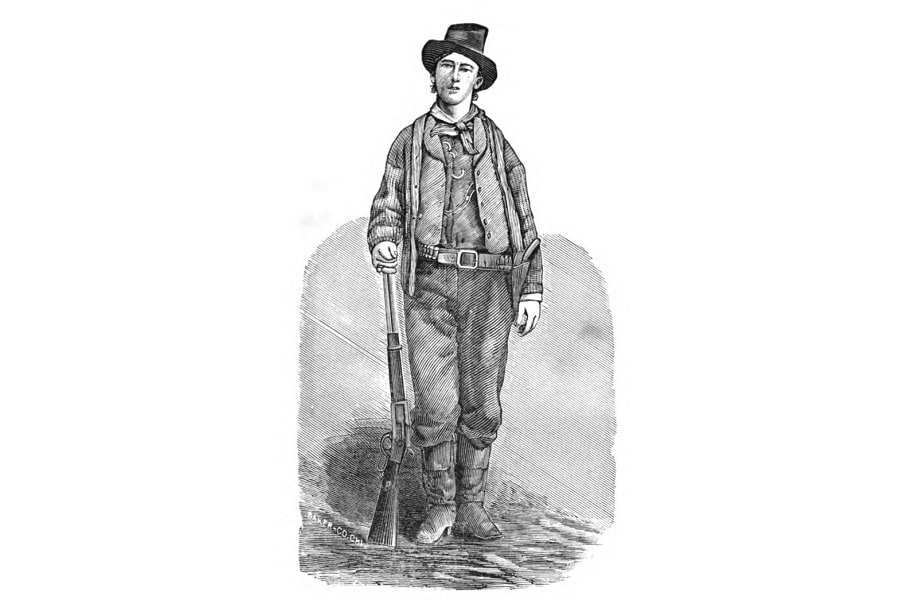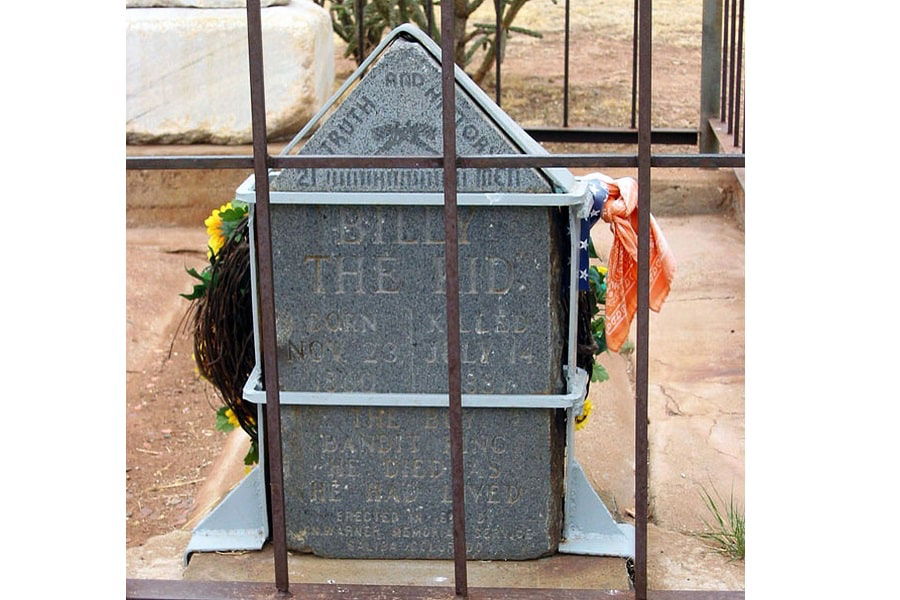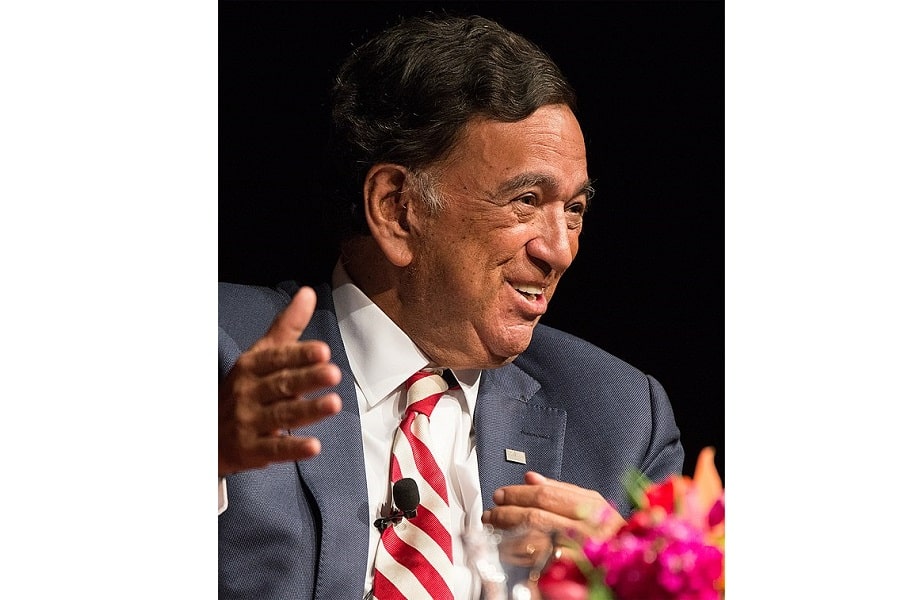The classic story is that William Bonney, aka Billy the Kid, was shot by Sheriff Pat Garrett on the night of July 14th, 1881, at Fort Sumner in New Mexico. The 21-year-old Bonney had been on the run from Garrett since April, after escaping his jail in Lincoln County.
But details of that official account are limited. Just like much of what we know of his life, the details of Bonney’s death may be fuzzier than they appear – and the short, violent life of Billy the Kid may have gone on longer than official history claims.
Table of Contents
How Did Billy the Kid Die?

Billy entered the darkened bedroom of his friend, Pete Maxwell. The door had been standing open when he came to it, and it put the outlaw on alert. Pistol in hand, he walked into the darkness, asking who was there.
His friend Pete was still in bed, but Billy could tell something wasn’t right. Then Pete whispered something – not to him, but to someone else. “It’s him,” he’d said, and Billy, alarmed, raised his gun and backed away.
He asked again, this time in Spanish “Quien es? Quien es?” – “Who is it?” Yet – uncharacteristically – he didn’t fire, not sure where either his potential target or his friend might be in the dark.
That hesitation was a fatal mistake. An unseen man by Pete’s bed fired his own pistol. Billy fell as the man fired a second but unnecessary shot. He died on the spot, ending the 4-year career of the young outlaw from the Irish slums of New York City – born Henry McCarty, but remembered by the alias William Bonney, aka Billy the Kid.
The Great Escape
In the brutal feud known as the Lincoln County War, Billy and his gang, the Regulators, had dealt out their share of violent death. But it was the murder of the previous sheriff, William Brady, that most hung over Bonney’s head, and it was for that Garrett had tracked him to a cabin in New Mexico and captured him in December of 1880.
Charged with the murder of Brady, Bonney was sentenced to hang and confined under guard to Garrett’s office in the Lincoln County Courthouse. But he wouldn’t keep that date with the hangman – on April 28th of 1881, while Pat Garrett was away, Bonney made a daring escape.
He slipped out of his handcuffs – Bonney was well-known for having small hands and large wrists – and shot the deputy who’d been guarding him, James Bell, either with his own gun or possibly with one smuggled to him by his cohorts. He then killed a second deputy, Bob Olinger, who was approaching the courthouse after hearing the gunshot from across the street.
Freeing himself from his leg shackles, Bonney then helped himself to a number of weapons from the courthouse armory and fled on a stolen horse. He would evade the law for months until Garrett got word that Bonney was holed up at the home of an old friend, Pete Maxwell.

Fort Sumner
Fort Sumner – located northeast of Lincoln County, in neighboring De Baca County – had been abandoned by the US military in 1868 and sold to a cattleman name Lucien Maxwell. By 1880, it was the residence of Lucien’s son Pete and his family, various employees, and tenants.
Garrett traveled to the old fort with two deputies – John Poe and Thomas McKinney – arriving after nightfall. Knowing the residents of the fort were favorable to Bonney, they dismounted their horses out beyond an orchard, then stealthily proceeded past the various outbuildings toward Pete Maxwell’s residence.
In Garrett’s own account, they heard men conversing in Spanish (in which Bonney was fluent) some ways off, and a figure rose from among a group of men camped out near the orchard and jumped the fence, heading toward Maxwell’s house. Though too far away to identify at the time, this would later turn out to be Bonney, going to cut a piece of beef for a late-night meal.
The lawmen backtracked and approached Maxwell’s house by a different route to avoid alerting the rest of the group. Once there, Garrett left the other two men at the end of the porch and proceeded inside.
As it was now almost midnight, Garrett found Maxwell in bed, woke the man, and began interrogating him about the location of Bonney. Maxwell admitted that the outlaw had been around the fort but couldn’t say for certain where he was at the moment.
The Man in the Dark
Just then another man walked in through the open door and asked who was there. Garrett could tell little about him in the dark, except that he was hatless, apparently in his stocking feet, and carrying a pistol in one hand and a butcher’s knife in the other.
Garrett at first believed it might have been a member of Maxwell’s family, and whispered to Maxwell asking who it was but initially got no reply. The figure then moved closer to the bed, cautiously, and asked again “Who is it, Pete?”
Maxwell whispered, “It’s him,” to Garrett, and the figure suddenly backed away, raising the pistol, and crying out “Who is it” in Spanish. Garrett brought up his own pistol, fired, then dodged to the side and fired again. The figure fell and died on the spot, never getting off a shot of his own.

The Two Graves of Billy the Kid
Where is Billy the Kid buried? Well, that depends on who you ask. In the official account, a coroner’s inquest – held the next day – found that the man Pat Garrett shot was indeed the famous outlaw and that the shooting was justified.
Bonney was quickly interred in the nearby military cemetery at Fort Sumner in order to prevent ghoulish souvenir hunters from harvesting his effects or body parts (though many such supposed items were put on display in the years that followed). He was buried alongside two of his gang members who’d been killed the previous December – Tom O’ Folliard and Charlie Bowdre.
Unfortunately, floods in 1889 and 1904 both washed away the original headstones and likely moved and mingled the bones throughout the cemetery as well, leaving no way to know where the outlaw’s body lay. While locals at the time did mark the supposed location of Bonney’s grave prior to the floods, their answers were inconsistent and it’s impossible to say if any of them were offering anything better than a guess. Thus, even though an official grave site was ultimately selected, there’s reasonable doubt as to whether the man Pat Garrett shot is anywhere near it.
In 1931, a shared marker for the three men was commissioned by a local man named Charles Foor, who hosted tours of the cemetery. Nine years later, a Colorado stonecutter donated a second headstone for Bonney alone, placing it at the foot of his grave on March 23, 1940 – the day before Easter Sunday.
The plot had been surrounded by a chain link fence to deter souvenir hunters. But after the second headstone was stolen and recovered twice – once in 1950, then again in 1981, a large cage was placed around the entire plot to prevent any future thefts – though this troubled history did inspire the annual Fort Sumner Billy the Kid Tombstone Race, held each summer, in which racers run carrying an eighty-pound tombstone.

The Tale of Brushy Bill
But while the floods left doubt about whether Bonney is actually at the site of his tombstone, another twist in the story of Billy the Kid raises doubts that he’s buried at Fort Sumner at all. In 1950, a man named William “Brushy Bill” Roberts came forth with the astounding claim that he was, in fact, actually William Bonney, who’d evaded Garrett in 1881 and lived under an alias ever since.
In 1948, a man named Joe Hines, claiming to be a former associate of William Bonney, told a paralegal named William Morrison that Billy the Kid hadn’t died at Fort Sumner, but had been living in Texas for the last several decades. Intrigued, Morrison journeyed to Hico, Texas to meet with the then 90-year-old Roberts.
Seeking Amnesty
Brushy Bill claimed that he was tired of hiding his identity and had decided to come forward. In particular, he intended to claim the pardon then-governor of New Mexico Lew Wallace had supposedly promised Billy the Kid in 1879 in return for his testimony against a number of men in cases related to the Lincoln County War.
Whether such a pardon was ever seriously offered is unknown – New Mexico Governor Bill Richardson had ordered an investigation into the matter in 2002, hinting that he might issue the pardon himself if it were true, but decided against it when no evidence of such a deal was found. In any case, the deal – if it existed – wasn’t honored by the local district attorney, and Bonney was jailed until his final, bloody escape in April of 1881.

Claims and Evidence
Supporting Hines’ assertion, Roberts supposedly bore distinctive scars which matched wounds Bonney was known to have sustained. His identity was also confirmed by five other former associates of Bonney – Jose B. Montoya, Dewitt Travis, Martile Able, Robert Lee, and Severo Gallegos.
Each of them noted physical and other similarities between Bonney and Roberts, such as Billy the Kid’s famous small hands and large wrists, his general build, facial features, his speech patterns and laugh, and in particular his distinctive brown-flecked, blue-gray eyes. Able – who’d once cooked a meal for Bonney in her home – had even volunteered that it had been commonly known among Bonney’s friends that he hadn’t really been killed at Fort Sumner.
Other Evidence
At the time of the shooting, Deputy Poe had disputed that the man Garrett killed had been Bonney. In particular, Poe noted that the dead man sported a full beard, which the boyish Bonney didn’t have. And while Maxwell had initially identified the man as Bonney, he was said to have later recanted.
Of course, it must be noted that Poe had never met Bonney, and Maxwell’s later claim – if it happened – could be chalked up to simple opportunism as the myth of Billy’s survival took hold. Though the body was buried the following day, Garrett was said to have shown the body to numerous people as proof of the outlaw’s death, and there is still the finding of the inquest.
It’s worth remembering, however, that many of the locals were favorable to Bonney and may have been all too willing to confirm any mistaken identity. Likewise, Garrett would have certainly had his own obvious motivation for confirming that the man he shot dead in the dark was actually the wanted outlaw – leaving a shortage of truly objective witnesses as to the dead man’s identity.
Brushy Bill’s Legacy
The evidence of Brushy Bill’s identity as William Bonney was deemed insufficient by New Mexico authorities. Rebuffed, Roberts returned to Hico where he died in December of 1950.
But his claim didn’t die with him. The town of Hico embraced their local celebrity, and in the early 2000’s his simple tombstone was replaced with a larger one identifying him as Billy the Kid as well as William Roberts – and a few years later added an arch over the grave with an additional inscription identifying Roberts as the outlaw.
The town now sports a Billy the Kid Museum in Hico’s historic district, which purports to lay out the evidence backing the idea of Roberts as Billy the Kid. There is also a statue of Billy the Kid downtown, at the corner of N. Pecan and 2nd street – along with a plaque likewise supporting Brushy Bill’s claim.

Later Evidence
While Roberts’ claim was dismissed in his time, additional evidence provided later may lend credence to his story. Computer technology unavailable in 1950 may well have corroborated the claims of Bonney’s former friends regarding Roberts’ strong resemblance.
A digital photo-comparison of photos of Roberts and the famous tintype image of Billy the Kid was conducted in 1990 at the University of Texas at Austin. The results of the study, finally presented in 1996, showed an extremely high correlation between the two men, with the only notable differences likely accounted for by age-related weight gain and Roberts’ loss of his teeth.
Dead Ends
But a different technological advance – one which might have settled the matter once and for all – can sadly be of no help. A 2003 attempt to use DNA evidence to confirm Billy the Kid’s identity degenerated into a decade-long legal slugfest between advocates of testing and defenders of the official account.
An attempt was made to extract DNA from a wooden bench in Albuquerque on which Bonney had supposedly bled while petitions were filed to exhume both Bonney and his mother, Catherine Antrim, who was buried in Silver City, so DNA samples could be taken. Unfortunately, Antrim’s body was no easier to locate than her son’s (her burial site, Plot D-27 at Memory Lane Cemetery, is known to hold at least 12 individuals and quite likely more – and experts doubt usable DNA could be extracted even if they did somehow confirm which remains were hers), and in any case, both exhumations were ultimately blocked.
READ MORE: Who discovered DNA?
The controversial Lincoln County sheriff who was behind the effort to confirm Bonney’s identity tried to salvage the quest by testing the remains of John Miller – a rancher who had also borne a strong resemblance to Bonney and was said to have privately confided to friends that he was the former outlaw. But without a comparison sample from the bench or the other remains, that effort came to naught as well – leaving the final truth on the death of Billy the Kid a mystery.